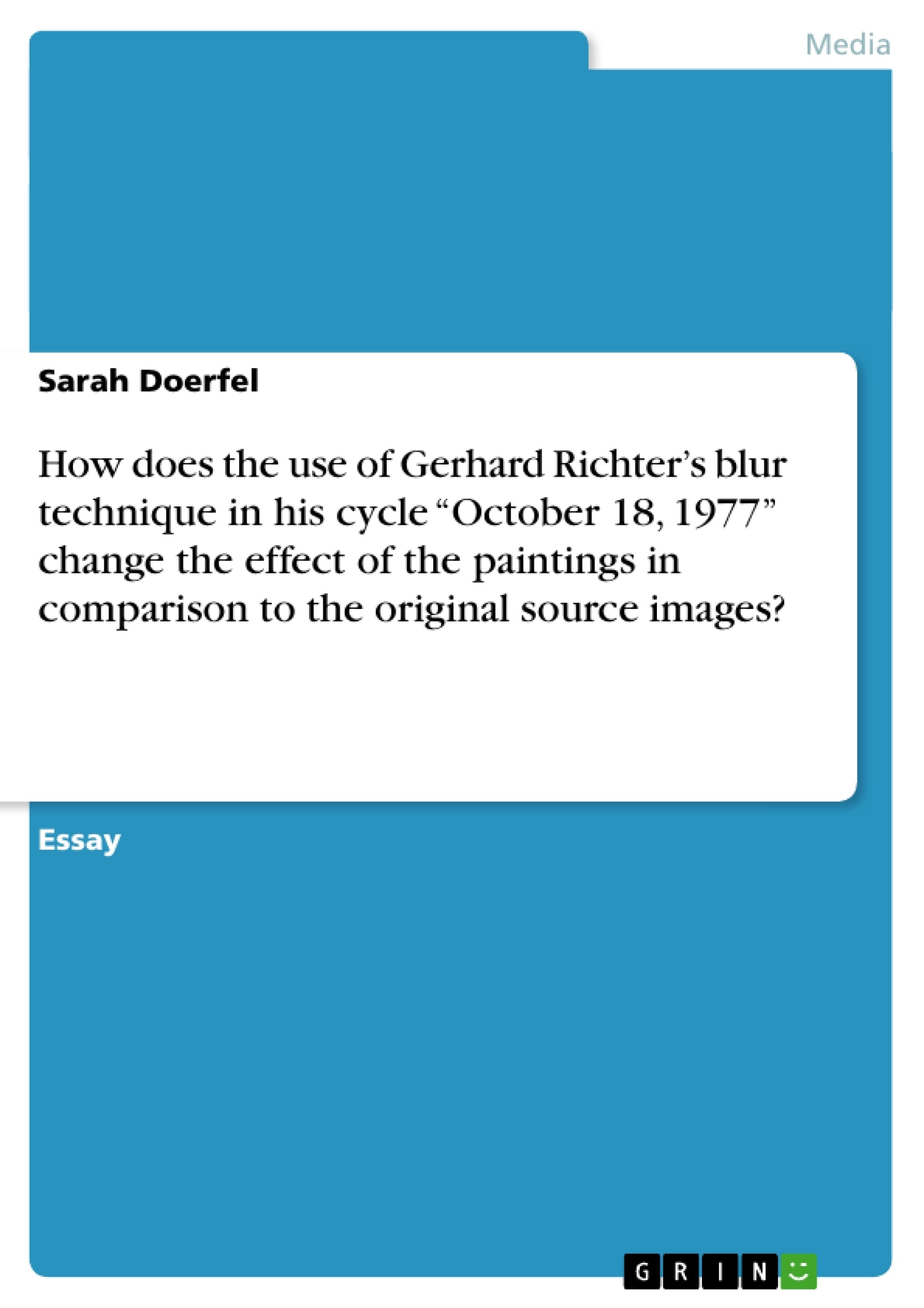Gerhard Richter is one of the most successful contemporary artists. His work is known for being very diverse and having no specific style seems to be his style. His apparent lack of a clear commitment to a style, an opinion, or a political standpoint can also be found in his blur technique which he uses for his paintings from photographic originals: blurring the originally sharp images abstracts them. Richter’s point of view seems to be hidden behind a thin but insurmountable curtain. The blur also keeps the viewer from seeing clear himself, from judging the situation, from taking on a standpoint. The painter has to confront this criticism of having no opinion especially with his political historical subjects, like the paintings “Onkel Rudi /Uncle Rudi” (1965) or “Tante Marianne/ Aunt Marianne” (1965), which show relatives of Richter in the context of Nazi Germany. Apart from these, especially the cycle “October 18, 1977” made onlookers search for the artist’s opinion and intention, as these 15 paintings do not show a political subject represented on the basis of family photographs, like his earlier works. The cycle’s source images are press and police photographs and it deals with the events around the Baader- Meinhof gang, a group of terrorists active in Germany in the 1970s. At the time Richter chose to paint this subject, the events had already passed for more than a decade, which seems like he wanted to say something about it that he felt was missing but essential to close this chapter of history. Viewers and critics are therefore looking for his statement in the painting but cannot find what they expect. The painter is criticized for picking a controversial subject, attracting attention to the issue, raising questions but refusing to offer an opinion and refuse an answer. The artist himself, though, says, that “the political topicality of my October paintings means almost nothing to me” (Richter, 1968, n.p.).
In the following essay I want to concentrate on the blur effect in Richter’s cycle “October, 18 1977”. I will show how the blur changed the effect of the source photographs and that the artist’s statement lies exactly there. When generally “blur” stands for obscuring the clear sight on a subject, this is arguable for the cycle: Through the blur, the viewer here much more gets the chance of a real encounter with these images. This essay will focus on the comparison of the effect of the original photographs and Richter’s version.
Table of Contents
- Introduction
- The Blur Effect in Richter's Cycle "October 18, 1977"
- The Source Images
- The Blur and the Viewer's Perspective
- Conclusion
Objectives and Key Themes
This essay examines the blur technique employed by Gerhard Richter in his cycle "October 18, 1977," analyzing how it alters the effect of the original source images. The objective is to understand how the blur transforms the viewer's experience, allowing for a more nuanced and respectful engagement with the subject matter.
- The role of the blur technique in transforming the viewer's perspective
- The ethical implications of portraying death and suffering in art
- The impact of media coverage on public perception of events
- The relationship between the artist's intentions and the viewer's interpretations
- The use of photography as a source for artistic expression
Chapter Summaries
The essay begins by introducing Gerhard Richter and his distinctive use of blurring in paintings derived from photographic originals. It establishes the context for the analysis of "October 18, 1977," highlighting the artist's inclination towards ambiguity and the blurring technique's role in obscuring a clear viewpoint. The essay then delves into the source images, examining the press and police photographs depicting the deaths of members of the Baader-Meinhof gang. The essay analyzes the voyeuristic nature of these images and their potential to evoke discomfort and shame. Finally, the essay explores how Richter's blur technique alters the viewer's experience, allowing for a more contemplative and respectful engagement with the subject matter.
Keywords
The essay focuses on the key themes of blurring, photography, death, media representation, voyeurism, and ethical considerations in art. It explores how Richter's artistic choices address the complex relationship between viewer and subject, inviting a deeper understanding of the events surrounding the Baader-Meinhof gang. The analysis centers on the blur technique as a means of achieving a critical distance, fostering reflection and promoting a more ethical encounter with the tragic events.
- Quote paper
- Sarah Doerfel (Author), 2011, How does the use of Gerhard Richter’s blur technique in his cycle “October 18, 1977” change the effect of the paintings in comparison to the original source images?, Munich, GRIN Verlag, https://www.grin.com/document/208046




